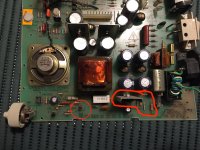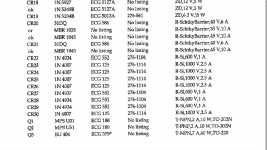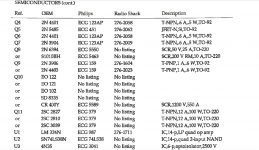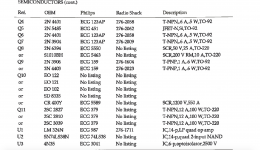I'm feeling like this is the 'Plus Q10 / Q12' thread, so I'm going to add some additional insights here for reference. No guarantees it will make sense.
From some digging around, it would seem the determining factor in finding a working replacement SCR for this component is a very low turn off time (tq), in order for Q10 to avoid conflicting with Q11 during their self-oscillation cycle. The E0102 / E0122 have a tq
MAX of 10μs, where the suggested newer 30V/0.8a replacements (2N5060, NTE5600, even the BRX44) have a tq of 10μs
TYPICAL, or slower, if tq is even listed on the datasheet...
The 2N5060's and BRX's sometimes work because of production inconsistencies, and some will happen to be fast enough but it's a gamble. A resistor on the gate may also work with some as it may desensitize the circuit... but it's also a gamble without an oscilloscope for the same reason.
Unfortunately 'fast' SCR's are no longer being made as the kind of circuit we're dealing with here has been obsolete for a while. One option that still seems to be kicking around at the moment is the BR103 - there seem to be a few available (mostly on the east side of the Atlantic (
https://www.ebay.com/sch/i.html?_from=R40&_trksid=p2334524.m570.l1313&_nkw=br103+thyristor&_sacat=0&LH_TitleDesc=0&_osacat=0&_odkw=br103+scr), I got mine from Germany), and they have a tq max of 6μs and I can confirm they work as a direct replacement (CGA is reverse from E01012/E0122/2N5060 with an offset gate pin, but the board is ready for it).
What I'm interested in is what we do when reliable replacements are no longer available. I'm intrigued by the idea of *making* fast SCR's with a pair of fast high-voltage bipolar transistors and some passives in SCR configuration, and something that seems to end up there in this Hackaday post:
https://hackaday.io/project/168100-fat-macintosh-repair/details
This is beyond my capabilities to design (I'm no EE that's for damn sure), but the idea of breadboarding a fast SCR in this way with modern components seems like a path forward.
E01012YA datasheet
2N5060 datasheet
BR103 datasheet attached
View attachment BR103.pdf







